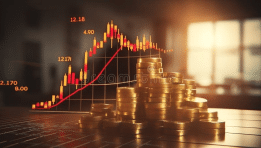Analyzing the 3 Reasons the Stock Market Could Be Overheating This Summer
The stock market is often regarded as a barometer of economic health, and during the summer months, it can exhibit unpredictable movements. As you navigate the investment landscape this summer, it’s crucial to stay alert to signs that the market may be overheating. Here are three key reasons that could signal excessive market activity.
1. High Valuations Across Sectors
One significant reason the stock market might be overheating is the high valuations evident across various sectors. Over the past months, many companies have reported record-high earnings, leading to elevated price-to-earnings (P/E) ratios. An increased P/E ratio can often indicate that stocks are overpriced, even if companies are performing well.
When valuations soar, investors may start to buy on speculation, pushing prices higher without fundamental backing. This scenario can create a bubble, where the stock prices reflect investor enthusiasm rather than real financial health. It’s essential to consider whether the increased prices align with earnings growth or if they stem from unrealistic expectations.
2. Rising Inflation Concerns
Another factor to keep in mind is the rising concerns surrounding inflation. The economy has shown signs of inflationary pressures, which can significantly impact the stock market. As inflation rises, consumers have less purchasing power, potentially decreasing corporate earnings in the long run.
Higher inflation often leads to increased interest rates as central banks may respond to curb spending. Rising interest rates can make borrowing more expensive for businesses. If companies face increased costs, they might cut back on investments or hiring, ultimately affecting their bottom line. This scenario could trigger a downward spiral in stock prices, raising concerns of an overheating market.
3. Increased Retail Investor Participation
The surge in retail investing, especially recently, plays a crucial role in the current market dynamics. With the advent of commission-free trading platforms and increased access to market information, more individual investors have begun participating in the stock market. This trend can generate volatility and contribute to the market overheating.
When retail investors jump in during a market upswing, they often buy without the same level of analysis that institutional investors might apply. Fear of missing out (FOMO) can drive irrational buying behaviors, inflating stock prices beyond sustainable levels. Furthermore, the emotional nature of retail investors can lead to sharp sell-offs, amplifying market swings and instability.
Keep an Eye on Indicators
It’s worth being vigilant and monitoring several indicators to gauge whether the stock market is indeed overstretched. Here are some signs to watch for:
- Market Sentiment: Check sentiment indicators such as the Fear & Greed Index, which can provide insights into whether investors are too optimistic.
- Volume Trends: Look at trading volumes. High volumes during a market climb can indicate strong buying pressure, whereas declining volume might suggest weakening momentum.
- Technical Indicators: Utilize technical analysis tools to help identify trends and potential reversal points in stock prices.
By keeping abreast of these factors, you can make more informed decisions about your investments. The stock market can provide vast opportunities, but being aware of potential overheating signals can help protect your portfolio from downturns.
Ultimately, understanding these three reasons why the stock market could be overheating this summer is essential for any investor. Whether it’s keeping an eye on valuations, having conversations about inflation, or being aware of retail participation patterns, staying informed will empower you to navigate the market more effectively.
Understanding the Impact of Economic Indicators on Stock Market Trends
Economic indicators play a crucial role in guiding investors when navigating the stock market. These indicators help assess the overall health of the economy, influencing stock market trends significantly. Below, we delve into some key economic indicators and their effect on stock market movements. Understanding these signals can empower you as an investor to make informed decisions.
GDP Growth Rate
The Gross Domestic Product (GDP) growth rate is one of the most fundamental indicators of economic performance. It reflects how much the economy is growing or shrinking over time.
- Positive Growth: When the GDP growth rate is positive, it often signifies a robust economy. Companies may see increased sales and profits, leading to rising stock prices.
- Negative Growth: Conversely, if the GDP declines, it can indicate recessionary pressures. Investors may sell stocks, fearing lower corporate earnings.
Monitoring GDP growth can provide insights into long-term market trends. For instance, if the economy consistently shows strong GDP growth, it might be time to consider investing more aggressively in the stock market.
Unemployment Rate
The unemployment rate is another essential economic indicator. A low unemployment rate generally suggests a strong job market, which can boost consumer confidence and spending.
- Low Unemployment: A declining unemployment rate can be a positive sign for the stock market. More people working means more disposable income, which usually leads to higher sales for companies.
- High Unemployment: On the other hand, a rising unemployment rate often leads to lower consumer spending. This may cause businesses to struggle, negatively impacting stock prices.
As an investor, you should keep an eye on the unemployment figures released every month. Large shifts in unemployment rates can influence market sentiment and prompt drastic fluctuations in stock valuations.
Inflation Rates
Inflation measures the rate at which general prices for goods and services rise. The Federal Reserve often uses inflation as a guide for adjusting interest rates. Understanding its impact is vital for making wise investment choices.
- Moderate Inflation: Moderate inflation can be healthy for the economy. It can encourage spending and investment, potentially driving stock prices up.
- High Inflation: However, soaring inflation may lead to rising interest rates. Higher borrowing costs can stifle economic growth. Companies may see profit margins shrink, leading to lower stock prices.
When following inflation trends, you want to consider how they could influence interest rate changes, which in turn affect stock market valuations.
Interest Rates
Interest rates directly impact borrowing costs for consumers and businesses, influencing overall economic growth. The Federal Reserve adjusts these rates based on various economic conditions.
- Low-Interest Rates: When interest rates are low, borrowing is cheaper. This often encourages businesses to invest and expand, which can drive stock prices higher.
- High-Interest Rates: Conversely, when interest rates rise, borrowing costs increase. This discourages investment and spending, which can negatively impact stock prices.
As an investor, it’s essential to pay attention to interest rate policies announced during Federal Reserve meetings. These can significantly influence investor sentiment and market trends.
Consumer Confidence Index
The Consumer Confidence Index (CCI) gauges how optimistic or pessimistic consumers are about the economy’s future. A high CCI often correlates with increased consumer spending, directly influencing stock performance.
- High Confidence: When consumer confidence is high, people are more inclined to spend, which can boost company earnings and lead to rising stock prices.
- Low Confidence: A dip in consumer confidence can signal a slowdown in spending, potentially leading to decreased profits and falling stock prices.
Tracking the Consumer Confidence Index can give you valuable insights into future market performance and help you strategize your investments accordingly.
Understanding the impact of economic indicators on stock market trends is vital for any investor. Keeping a close watch on GDP growth, unemployment rates, inflation, interest rates, and consumer confidence can provide the knowledge needed to navigate the market effectively. Armed with this information, you can make informed decisions that may enhance your investment portfolio.
Conclusion
As we dive deeper into the dynamics of the stock market this summer, it is crucial to stay informed about the potential factors that could contribute to an overheating scenario. The economic indicators we explored not only signal current trends but also act as crucial signposts for future movements. For instance, rising inflation rates tend to erode purchasing power, which can lead to investor anxiety and market volatility. Similarly, climbing interest rates often act as a brake on economic growth, causing shifts in investor sentiments.
Moreover, the fierce rally observed in stock prices has raised concerns about sustainability. Rapid price increases can lead to speculation, creating an unstable environment that may not be grounded in the underlying fundamentals of companies. This disconnect can result in a market correction, caught between the euphoria of rising valuations and the stark reality of economic performance.
As summer unfolds, it’s essential to monitor your investments actively and consider how these economic indicators may affect your portfolio. Whether you’re an experienced investor or just starting out, understanding these factors can empower you to make informed decisions. Keeping a close eye on inflation figures, interest rate changes, and overall market sentiment can provide valuable insights into the health of the stock market. By staying vigilant, you can navigate the potential tumult of an overheating market, positioning yourself for long-term success.
Comparison, examination, and analysis between investment houses
Leave your details, and an expert from our team will get back to you as soon as possible
* This article, in whole or in part, does not contain any promise of investment returns, nor does it constitute professional advice to make investments in any particular field.
To read more about the full disclaimer, click here- orshu
- •
- 9 Min Read
- •
- ago 2 hours
 PAKISTAN AND US REACH A TRADE AGREEMENT TO DEVELOP OIL RESERVES AND REDUCE TARIFFS
PAKISTAN AND US REACH A TRADE AGREEMENT TO DEVELOP OIL RESERVES AND REDUCE TARIFFS
Pakistan and US Forge Trade Agreement on Oil Reserves and Tariffs A recent trade agreement between Pakistan and the
- ago 2 hours
- •
- 9 Min Read
Pakistan and US Forge Trade Agreement on Oil Reserves and Tariffs A recent trade agreement between Pakistan and the
- orshu
- •
- 9 Min Read
- •
- ago 3 hours
 European Markets Close Mixed as Trade Tensions and Earnings Season Weigh In
European Markets Close Mixed as Trade Tensions and Earnings Season Weigh In
Europe's major stock indices concluded the trading day with a mixed performance, reflecting investor reactions to a busy earnings season
- ago 3 hours
- •
- 9 Min Read
Europe's major stock indices concluded the trading day with a mixed performance, reflecting investor reactions to a busy earnings season
- orshu
- •
- 6 Min Read
- •
- ago 4 hours
 BIOGEN RAISES ANNUAL PROFIT FORECAST ON STRONG DEMAND FOR RARE DISEASE DRUGS
BIOGEN RAISES ANNUAL PROFIT FORECAST ON STRONG DEMAND FOR RARE DISEASE DRUGS
Biogen's Performance Driven by Rare Disease Drugs Biogen is seeing a significant boost in its financial performance due to
- ago 4 hours
- •
- 6 Min Read
Biogen's Performance Driven by Rare Disease Drugs Biogen is seeing a significant boost in its financial performance due to
- orshu
- •
- 8 Min Read
- •
- ago 5 hours
 Americas Market Snapshot: Navigating Mixed Signals on July 31, 2025
Americas Market Snapshot: Navigating Mixed Signals on July 31, 2025
Introduction As of Thursday, July 31, 2025, the Americas markets are presenting a mixed bag of performance, with some key
- ago 5 hours
- •
- 8 Min Read
Introduction As of Thursday, July 31, 2025, the Americas markets are presenting a mixed bag of performance, with some key












